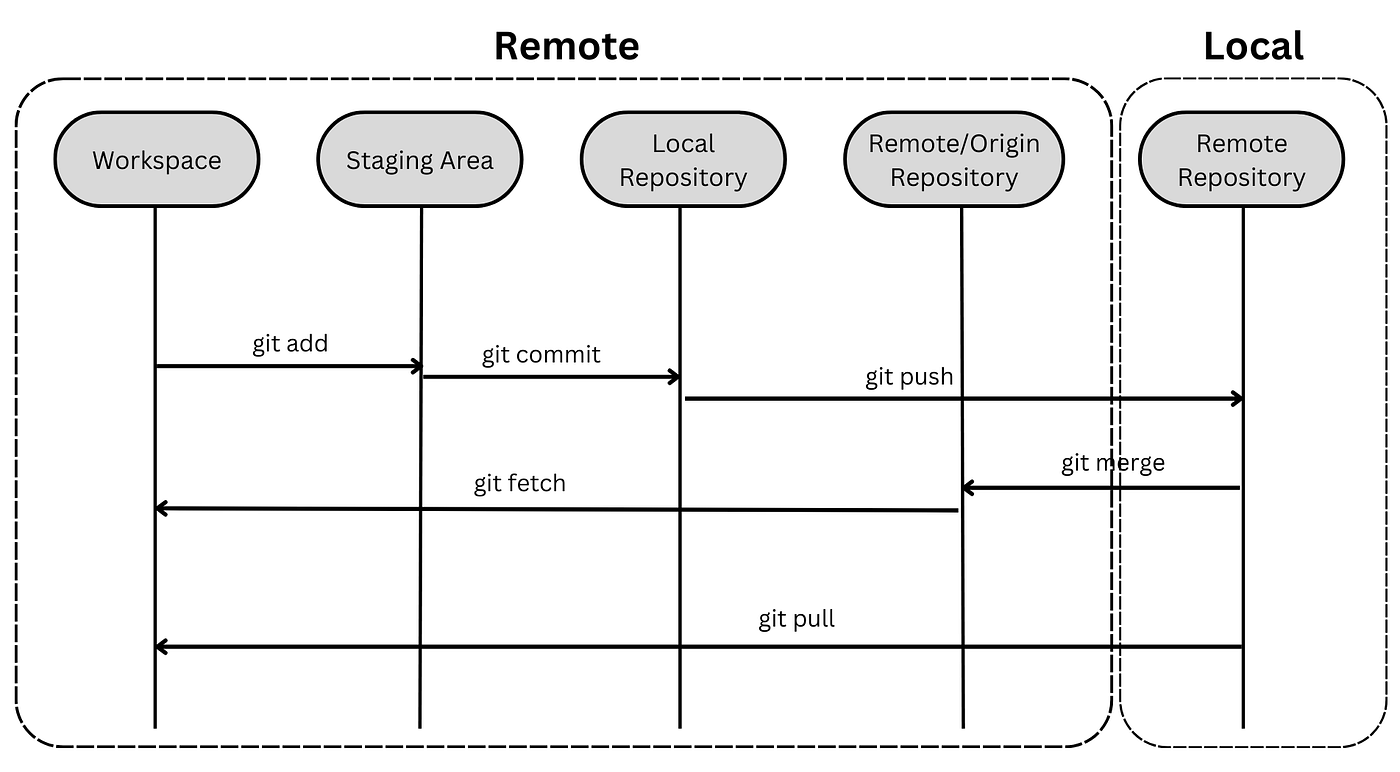Mastering Git: A Beginner’s Guide to Essential Commands and Collaboration
 Aayushi Chourasiya
Aayushi ChourasiyaGit is a helpful tool used by programmers to keep track of changes made to their projects. Imagine it as a safe and secure storage system for different versions of your project files. This guide will show you some essential Git commands to get you started!
Let’s get Git installed on your laptop!
Download Git: Go to the Git website and download the version for your operating system (Windows, macOS, or Linux).
Install Git: Run the installer and accept the default settings.
You’re all set! Git is now installed on your computer.
Understanding the Git Workflow

This diagram represents the basic workflow in Git:
Workspace: Your local files where you make changes.
Staging Area is where you prepare your changes.
Local Repository is where Git stores the complete history.
Remote Repository: where we upload changes to a remote server.
Setting Up Git
1. Configure Git
Before using Git, set your name and email address:
$ git config --global user.name "Your Name"
$ git config --global user.email "your.email@example.com"
Now, you can verify these configurations by running the below commands.
git config --global user.name
git config --global user.email
Your git is now configured.
Working with Repositories
2. Clone a Repository
To get a copy of an existing repository:
$ git clone <repository-url>
3. Initialize a New Repository
Start tracking your project with Git:
$ git init
Example:
$ git init my-new-project
Making Changes
4. Check Status
See the status of your working directory and staging area:
$ git status
5. Add Changes
Stage changes for commit:
$ git add <file>
Example:
$ git add index.html
To add all changes:
$ git add .
6. Commit Changes
Save changes to the repository:
$ git commit -m "Your commit message"
HEAD points to the latest commit in your active branch.
7. Reset Changes
Unstage changes or reset to a previous state:
$ git reset <file>
To reset the entire working directory:
$ git reset --hard
Branching and Merging
8. Create a Branch
Branches allow you to work on different parts simultaneously. To create a new branch to work on:
$ git branch <branch-name>
9. Switch Branches
Move between branches:
$ git checkout <branch-name>
10. View Branches
List all branches in the repository:
$ git branch
Synchronizing with Remote Repositories
11. Push Changes
Upload local changes to a remote repository:
$ git push origin <branch-name>
12. Pull Changes
Fetch and merge changes from a remote repository:
$ git pull origin <branch-name>
13. Fetch Changes
Download updates from a remote repository without merging:
$ git fetch
Reviewing History
14. View Log
See a history of commits:
$ git log
Example:
$ git log --oneline
Advanced Commands
15. Rebase Changes
Reapply commits on top of another base tip:
$ git rebase <branch-name>
Simple Git for Collaboration
Git facilitates collaboration among multiple developers by allowing them to work on different parts of the project simultaneously. Key concepts include:
Forking: This means making a copy of someone else’s project (repository) so you can work on it without affecting the original project. For example, if you see a project on GitHub that you like, you can “fork” it to create your version where you can make changes.
Pull Requests: After you make changes in your forked project, you can suggest those changes to the original project by creating a “pull request.” It’s like saying, “Hey, I’ve made some improvements — can you review and possibly add them to the main project?”
Merge Conflicts: These happen when two people make changes to the same part of a file at the same time, and Git doesn’t know which version to keep. To fix a merge conflict, you need to go into the file and decide which changes should stay, then save and commit those changes.
Ignoring Files
Use a .gitignore file to exclude specific files or folders from version control. Create a .gitignore file and list the files/folders to ignore:
# Example .gitignore file
node_modules/
*.log
.env
Example:
echo "node_modules/" >> .gitignore
echo "*.log" >> .gitignore
echo ".env" >> .gitignore
Remote Repositories in Detail
Remote repositories (like GitHub, GitLab, and Bitbucket) are online places where your code is stored, so others can see and work on it with you. To push and pull code from these platforms, use:
$ git push origin <branch-name>
$ git pull origin <branch-name>
Undoing Mistakes
To undo a commit:
$ git revert <commit-hash>
To roll back to a previous commit:
$ git checkout <commit-hash>
By mastering these basic commands, you can start working efficiently with Git and manage your code like a pro. Thanks for reading till the end! Happy coding!
Let’s stay connected! Find me on LinkedIn.
Subscribe to my newsletter
Read articles from Aayushi Chourasiya directly inside your inbox. Subscribe to the newsletter, and don't miss out.
Written by

Aayushi Chourasiya
Aayushi Chourasiya
Java Backend Developer | Passionate about creating applications. Skilled in Java, Spring Boot, Hibernate, and AWS.